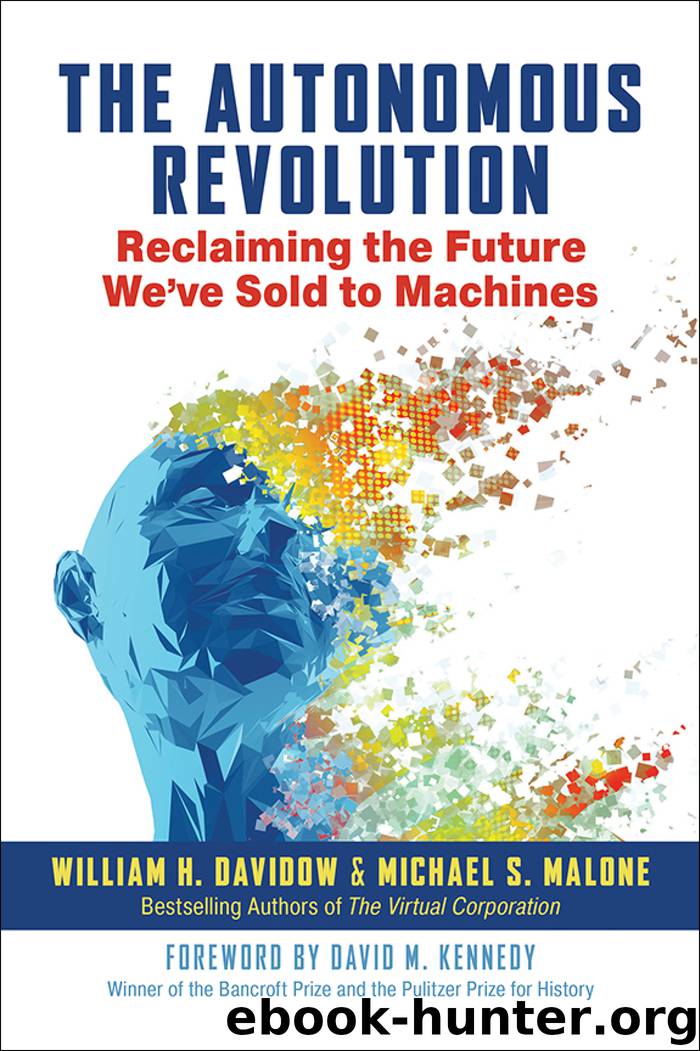The Autonomous Revolution by William H. Davidow

Author:William H. Davidow
Language: eng
Format: epub
Publisher: Berrett-Koehler Publishers
Published: 2020-02-19T16:00:00+00:00
DEFENDING PRIVACY
Throughout this book, we have argued that phase change creates new rules and new institutions. In many cases, we will need to establish new laws and regulations to control the behavior of those new institutions.
One example of this is the General Data Protection Regulation (GDPR) that the European Union put into effect on May 25, 2018.28 The rule requires opt-in consent from users before data can be collected; that “by-default” sites use the highest possible privacy settings; and that personal data be made more difficult to tie back to an individual, either by using pseudonymization or a stronger form of encoding anonymization. Users must be informed of how long their data will be retained and be given the right to be digitally “forgotten.” Controllers would also be forced to design data protection into all systems by default, thus reducing the chances of theft.
If the United States were to adopt its own version of GDPR, it would certainly help. Until then, users will have to do a lot of work themselves to ensure they are protected. On a website run by Oath, the media firm created by the merger of AOL and Yahoo!, a user is asked for consent to “use your … data to understand your interests and personalize and measure ads.” If the user does not agree, he or she has the option to follow links … only to then discover that had they agreed, the user would have granted Oath permission to share their data with more than one hundred ad networks.29
It is highly likely that the GDPR will be improved and strengthened in the coming years. After all, it superseded weaker legislation—the Data Protection Directive—implemented in 1998.30 So one approach to solving the problem is to chip away at it, every decade or so bringing out a new version of the GDPR. In all likelihood this will be the chosen solution.
Still, we would argue that the GDPR is an all-too-typical example of using Industrial Revolution rules to deal with Autonomous Revolution issues.
If we really want to solve the problem of Internet privacy, we have to engage in phase-change solution thinking. What is really broken here is the defective freemium business model of the Internet—and the way to solve that problem is to give the user complete ownership and control over his or her data.
One way to do this would be to create information fiduciaries that would hold individuals’ information. Think of the fiduciary as a personal information safety deposit box that can be unlocked only if the holder supplies a key or knowingly withdraws the information and sends it to the desired recipient.
These fiduciaries would have the right to collect all the personal information they can from legal sources. The owner, in turn, would have complete control over who can access the information stored with a fiduciary.
The fiduciary would organize the information by tiers or levels. The first level would be pretty innocuous stuff, while the highest level would be highly sensitive kinds of information that an owner would permit only a limited number of institutions to view.
Download
This site does not store any files on its server. We only index and link to content provided by other sites. Please contact the content providers to delete copyright contents if any and email us, we'll remove relevant links or contents immediately.
| AI & Machine Learning | Bioinformatics |
| Computer Simulation | Cybernetics |
| Human-Computer Interaction | Information Theory |
| Robotics | Systems Analysis & Design |
Algorithms of the Intelligent Web by Haralambos Marmanis;Dmitry Babenko(13730)
Jquery UI in Action : Master the concepts Of Jquery UI: A Step By Step Approach by ANMOL GOYAL(8240)
Test-Driven Development with Java by Alan Mellor(7704)
Data Augmentation with Python by Duc Haba(7582)
Principles of Data Fabric by Sonia Mezzetta(7353)
Learn Blender Simulations the Right Way by Stephen Pearson(7276)
Microservices with Spring Boot 3 and Spring Cloud by Magnus Larsson(7109)
RPA Solution Architect's Handbook by Sachin Sahgal(6504)
Hadoop in Practice by Alex Holmes(6380)
The Infinite Retina by Robert Scoble Irena Cronin(6198)
Big Data Analysis with Python by Ivan Marin(5906)
Life 3.0: Being Human in the Age of Artificial Intelligence by Tegmark Max(5479)
Pretrain Vision and Large Language Models in Python by Emily Webber(4875)
Infrastructure as Code for Beginners by Russ McKendrick(4644)
WordPress Plugin Development Cookbook by Yannick Lefebvre(4359)
Functional Programming in JavaScript by Mantyla Dan(4341)
The Age of Surveillance Capitalism by Shoshana Zuboff(4216)
Embracing Microservices Design by Ovais Mehboob Ahmed Khan Nabil Siddiqui and Timothy Oleson(4137)
Applied Machine Learning for Healthcare and Life Sciences Using AWS by Ujjwal Ratan(4119)
